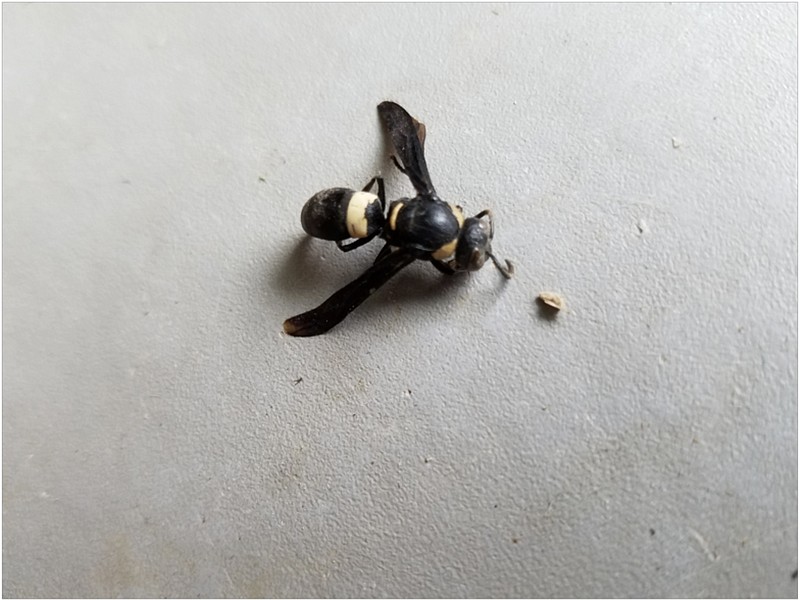Q: These wasps are back by the thousands again this year, flying and hovering over an area of my lawn, occasionally dipping down into the grass. They seem to be congregating in one spot. Are they a social insect? Or is this about something else?
A: It is the four-toothed mason wasp, Monobia quadridens, in the family Vespidae. (Thanks to Kris Simpson Collections Manager at the Enns Entomology Museum at University of Missouri for assistance) They are a beneficial predator and will keep to themselves, but can sting if bothered. They are frequently mistaken for the Bald Faced Hornet. They are considered solitary, but they may source for food or next in the same general area, such as cicada killer wasps will do.
It is doubtful they are nesting there, as they generally choose a variety of cavities, such as tunnels abandoned by carpenter bees, old mud dauber nests and hollow plant stems. A primary food source for them are small caterpillars, some of which are prevalent in plant stems and roots. Other examples are leaf rollers and miners. They may be active in that area and it is attracting them. They also eat a lot of pollen.
Q: There is a papery nest up in a tree in my yard, 12-15 feet high. I can see them going in and out, and they are mostly black. They don't bother me when I mow underneath. Do I need to be concerned about them? Should I remove the nest at sometime?
A: That is the baldfaced hornet, an "aerial yellowjacket," which is one of seven or eight species in the genus Dolichovespula in North America. All of these yellowjackets build nests in bushes and trees (sometimes on the outside of buildings), and produce the characteristic football shaped, grey papery nests. They are considered a beneficial insect and can be tolerated, given they aren't too close or around sensitive individuals. It gets its name from the ivory white markings on the face, but the body and legs also have white markings. Control of them is recommended if the nests are located close (within 10 feet) of an entrance to a building, under an eave that is close to the ground or in shrubbery next to a lawn that is mowed. Otherwise, the nests can be ignored. However, individuals with known sensitivities to wasp and bee stings should have any nests close to their homes removed by professional pest management personnel. They build a new nest every year, so you don't really need to take this one out in the winter. However, if you have a family member who is sure they will come back to it and keep increasing in number, removing it in the winter might be easier than arguing about it. If you have a nest you want to eliminate yourself, contact our extension center for recommendations.
Q: I saw in last week's article that there is a spreading, tall turf fescue. Is it available from any area retailers?
A: I found two seed brands that have this trait, which some area retailers are carrying. Do an internet search for either of these:
- Smith Seed TLC Tall Fescue Blend
- Water Saver Lawn Seed Mixture with Tall-Type Turf Fescues with RTF
Seed companies get to choose how they designate this trait, so it can be confusing. Last week's column referenced it as "RZ" and "RTF." TLC is being used by Smith Seed and I am sure there are other ways being used to note this trait.
Q: I'm noticing a lot of twigs laying under oak trees in particular. At first I thought it was the weather from tropical storm Gordon, but it didn't blow that hard. What is this?
A: Small branches accumulating on the ground and the presence of clean-cut twigs, and in some cases dangling branch tips within a tree, indicate the presence of beetle pests referred to as twig girdlers and twig pruners. Both of these long-horned beetle species (Cerambycidae) attack numerous types of shade, nut and fruit trees, hitting in late summer/early fall. Heavily damaged trees appear ragged and unattractive, and young trees can become deformed by repeated attacks. The way to tell which pest you have is by the appearance of the cut end of the twig. If it smooth on the outside, with a ragged center, then it is the twig girdler. If the outside of the twig is ragged, then is the twig pruner.
Generally, these pests are only a nuisance, but if reducing their presence is desired, it is easy to do and the same for both. Pick up the dropped twigs and burn, bury or send away. The larvae will develop in these dead twigs, as they can not develop in healthy growing sapwood. By removing them you'll lessen the adults that will hatch out right under that tree next year.

